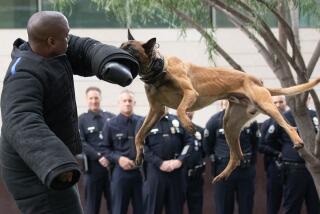Yellow Dogs, ‘Project X’ and the movie-violence equation
The tragedy that befell the Brooklyn punk group Yellow Dogs, in which several bandmates were killed, allegedly by a disgruntled fellow member of the Iranian expat music scene, came with a surprising movie connection.
Yellow Dogs was featured in the 2009 film “No One Knows About Persian Cats,” the acclaimed Kurdish director Bahman Ghobadi’s semi-documentary that won a prize at the Cannes Film Festival. Yellow Dogs was seen performing in the film, and the subsequent media attention actually helped allow members to emigrate from Iran.
Film titles have come up in association with tragedies several times over the last few days. At a shooting in suburban Houston over the weekend that claimed the lives of two young people, the Miles Teller till-the-break-of-dawn party movie “Project X” was invoked as, at the very least, helping create conditions for the violence.
PHOTOS: Behind the scenes of movies and TV
As my colleague Molly Hennessey-Fiske wrote, Harris County sheriff’s spokesman Thomas Gilliland “cited the rash of parties youths held in vacant Southern California homes earlier this year in an effort to mimic the movie ‘Project X,’ gatherings advertised online that drew hundreds and included drugs and alcohol.”
Said Gilliland, “Be aware of who’s coming to your house, who you invite. I wouldn’t use social media to invite people,” a reference to how that film’s over-the-top party came to be.
And on Monday, in a study that found the amount of violence in PG-13 movies has tripled since 1985, authors pointed to a “weapons effect,” which argues that seeing violence in movies can lead to hostile behavior on the part of the moviegoer.
“By including guns in violent scenes, film producers may be strengthening the weapons effect and providing youth with scripts for using guns,” said the study, which was published in the medical journal Pediatrics. “Many scientific studies have shown that violent films can increase aggression,” it added. They didn’t mention things like Houston or Yellow Dogs. But the implication was clear. As one reader bluntly put it, “The content of today’s films are one of the causes of the moral decline and increased violence in our society.”
Implicit in this argument is a long-held larger assumption: that movies give people “bad ideas” they wouldn’t have had on their own. Or, at the very least, that they provide a template for how to carry out those bad ideas.
PHOTOS: Fall movie sneaks 2013
Studies will reach their own conclusions, and at a moment of tragedy all causes should be investigated. Some of the reader mail that came in today is understandable, particularly for an older filmgoer who has seen a marked increase in on-screen violence over their lifetime.
But to me there’s always been something a little misplaced about the belief that movies give people bad ideas, and its logical extension that directors should thus refrain from showing particular kinds of scenes in their movies. Most thornily, it’s because it only seems to come up with certain kinds of cinematic behavior. You don’t hear many people saying that directors shouldn’t include scenes of, say, an affair in their romantic drama because it could lead to new instances of infidelity. For one thing, many movies about infidelity show the negative consequences of the act (as do a number of gunplay films, incidentally). And anyone who wanted to have an affair probably already had the notion long before they ordered that DVD of “Unfaithful.”
(What’s interesting is that, despite the tragic associations between Yellow Dogs and “Persian Cats,” the Ghobadi movie is actually one of the few films out there that did have a real-world effect — a quantifiable one, no studies or hypotheses needed. The publicity allowed the band members to flee to Istanbul and be welcomed at the U.S. Embassy, and then eventually to the U.S. itself.)
With a rash of high-profile shootings in the last year, the debate over movie violence’s role isn’t abating any time soon. Larger social factors are always more tempting to point to in a time of tragedy than the particulars of a given case, such as mental health or personal grievances. And there are many parties with added incentive to blame entertainment — not least of all the NRA, which has been banging the movie-violence drum as a distractive technique for a while now.
Psychologists will debate the interplay between movie violence and social behavior. Any right-thinking person — filmmaker and filmgoer — would do well to look at the nature of movie messages; Gus Van Sant said thoughtfully in our Tuesday story that whenever he includes an act of violence in one of his movies, he first weighs how it will land with a susceptible filmgoer.
But it seems, as it often does in these cases, that the idea that movies somehow instill bad ideas in us both overplays the importance of movies and underplays the importance of personal responsibility. Film can be an important social gauge — the barometer and mirror that auteurs like to talk about. Is it subtly brainwashing us or offering scripts for murderous behavior? That’s a tougher row to hoe.
David Denby famously wrote before the release of Spike Lee’s “Do The Right Thing” that “the movie is going to create an uproar” and that “if some audiences go wild, [Lee] is partly responsible.” They didn’t. And he wasn’t. Rather than influencing or providing road maps, movies seem more often to be depicting behaviors that are already there. Those are terrible and beautiful things, but they’re things that existed long before a film trend began and, beautifully or tragically, will exist long after.
ALSO:
Gun violence explodes in PG-13 films
Five dead in rampage tied to N.Y. rock group
Two arrested in Houston shooting publicized on social media
Follow me on Twitter @ZeitchikLAT
More to Read
Only good movies
Get the Indie Focus newsletter, Mark Olsen's weekly guide to the world of cinema.
You may occasionally receive promotional content from the Los Angeles Times.







